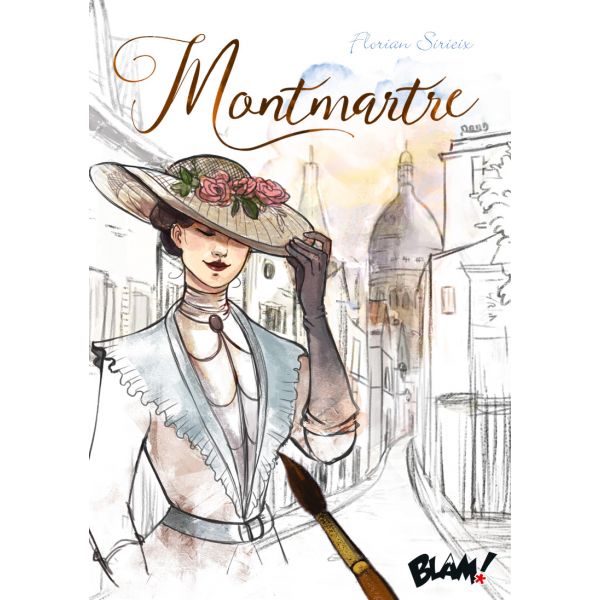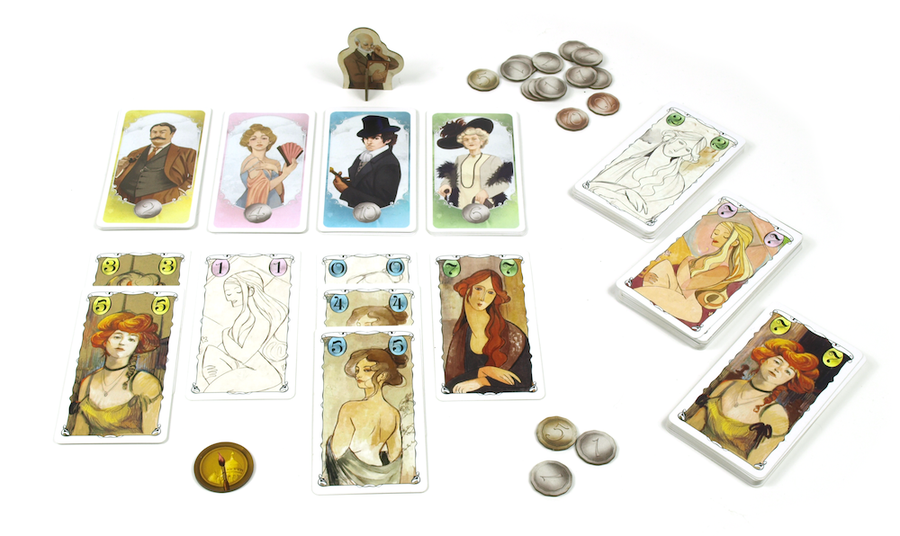Gain Fame and Patrons as a Burgeoning Artist in Montmartre

Sell paintings to markets and collectors to become a beloved master in this set collection card game from Florian Sirieix.
Gameplay
Montmartre is a 30-minute card game for 2-5 players which challenges players to gain sets of color-coded collectors by selling off corresponding art. Play begins with each player being dealt 4 cards, with the rest being shuffled and separated into three equal piles. Players may play any one card from their hand, which has a colored circle (matching a color of one of the collectors) and a value. Players may play two cards so long as the value of the two cards does not exceed a value of 5. After playing one’s cards, players will draw up to 4 cards from one of the three piles. Players can only draw from one of the piles during their turn.
As players begin to collect lines of similarly colored paintings, they can only hold up to six paintings. Therefore, they must sell either to the market or to collectors. Selling to the market can happen during a normal turn after cards have been played. Selling paintings only nets players one franc per card. Selling to a collector takes the place of playing cards into one’s tableau. To sell to a collector, they first must not be occupied by the Ambroise Vollard token, which prevents that collector from being able to purchase. Second, the paintings being sold must match the color of the collector. Lastly, players must either have the most paintings or have the highest value of the corresponding color. Collectors offer increasing points as players sell to them, ranging from 2 points up to 10 points. Once players sell to a collector, they may move the Ambroise Vollard token to another collector and play continues.
Optionally, players may then pick up a newspaper card after selling to collectors. Newspaper cards act as objective cards (players must gain two, three, or four collector cards of the same color) and provide bonus points at the end of the game if their conditions are met. However, players may only claim one newspaper card during the course of the game, so they must choose wisely when to claim a newspaper card. Also, if a player claims all the cards within a given tier, players may not retroactively claim a lower-tiered newspaper card until they meet the condition again. For example, if two players claim the newspaper cards for having four of the same collector while a third player is sitting on three collectors of a color, they may not claim the newspaper card for three collectors until they earn three collectors of a different color.
The game ends when 2 of the collector piles are empty or a player has collected 15 francs from selling to the market. The value of collector cards, francs, and any earned newspaper card are totaled with the highest value winning the game.

Review
Simple and elegantly designed, Montmartre blends basic mechanics found in traditional card games with some slight twists. Newspaper cards add a press-your-luck element, giving players weighty decisions of when to claim a newspaper card for guaranteed points or whether to keep going for high risk, but potentially a higher reward. The Ambroise Vollard token adds a bit of area control by allowing players to strategically sell paintings to collectors and to move the token to block off a collector their opponents may be working on. With a tableau size of only 6, it forces the play of someone else if they are denied the collector they were working on. Of course, the Ambroise Vollard token adds a bit of take-that to the game that may be a turn-off for less combative players.
Montmartre has a slight variant at two players, as well. Players may not sell to collectors until they can sell to two different collectors at once. Newspaper cards can only be earned by having pairs of collectors (for example, to earn the newspaper card with three card symbols in a two-player game, instead of having three of the same collector card players need three pairs of three different collectors). This allows for a quicker game with different strategies at play, which lends the card game a surprising amount of depth and replayability at different player counts.
Jeanne Landart’s art does a great job capturing the mood of the game’s theme, which is early 20th century France. There’s a blend of sophistication and novice to each, mirroring the game’s idea of each player trying to become a celebrated artist but also trying to sell a few paintings here and there to make ends meet.
Montmartre is the latest in small card games that offer more variety than at first glance. For families and casual gamers trying to introduce some new mechanics into game nights, Montmartre does so without being punishing to players with learning curves.
Pros: Player count variety, light strategy, familiar mechanics with slight twists
Cons: A bit of press-your-luck and take-that may be a turn off for less competitive gamers





Amazing! You mean these are cards for gaming? They look like cute paintings, I love the detail the artist did with every piece. Imagine if all products have these kind of artistry, well-thought, creative and impressive. Can we summon Monet?
https://5amily.com/painting/blog/top-10-monet-paintings-to-know-about